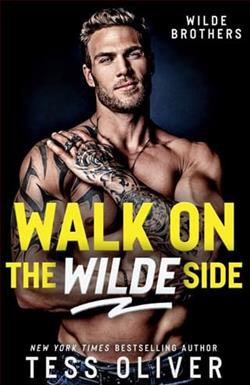Page 242 of Final Justice (Badge of Honor 8)
O’Hara took his picture.
Before the copilot could get back to the cockpit, there was the whine of an engine starting.
Joe D’Amata went to Homer Daniels.
Mickey O’Hara took their picture.
“The law says you cannot be restrained during takeoff, flight, or landing,” D’Amata said. “The law also says I have the authority to use what force is necessary to ensure that you remain in custody. What I’m going to do now is take those cuffs off you. What you’re going to do is fasten the seat belt. If you even look like you’re thinking of getting out of that seat, I’m going to shoot you. Do we understand each other?”
Daniels nodded.
D’Amata took the cuffs off.
The Citation started to move.
From where he was sitting, Matt could see everybody waiting for them to take off.
He didn’t think they could see him through the darkened windows of the Citation, but he waved anyway.
The Citation taxied down the runway, turned around, and immediately began the takeoff roll.
Matt could see that at least half the law enforcement officers on the tarmac were waving goodbye at them.
When he stopped looking out the window, Mickey O’Hara took his picture.
There weren’t quite as many people, or representatives of the Fourth Estate, on hand to meet the Citation at the Northeast Philadelphia Airport as there had been when Stan Colt’s Citation had arrived. But almost.
The Hon. Alvin W. Martin was there, sitting with a group of prominent officials and citizens at tables in the Flatspin Restaurant whose windows provided a view of aircraft using the main runway.
These included Police Commissioner Ralph Mariani- who was there primarily because he heard over Police Radio that the mayor was headed for the airport-and First Deputy Commissioner Dennis V. Coughlin-who was there because he wanted to be.
Sitting with them was Mr. Chadwick Thomas Nesbitt III, Chairman of the Executive Committee of Nesfoods International, who was there at the invitation of the mayor who intended to thank him publicly-that is, before the assembled TV and still cameramen-for his generous public-spirited offering of the airplane. Beside Mr. Nesbitt III was Mr. Chadwick Thomas Nesbitt IV, a vice president of Nesfoods International, who was there because he had called the Nesfoods International aviation department and asked to be informed of the arrival of the Citation.
When word was passed that the Nesfoods Citation had just requested landing and taxi instructions, Mr. Nesbitt IV was engaged in conversation with Mr. Stan Colt, the film actor, who had somehow acquired a zipper jacket with the legend PHILADELPHIA POLICE DEPARTMENT on it.
Also sitting in the VIP section of the Flatspin, so to speak, were the proprietor, Mr. Fred Hagen; Mr. Brewster Cortland Payne II, Esq., and Amelia M. Payne, M.D. The latter two had been informed of the arrival time by Commissioner Coughlin. Mr. Payne was there as a proud parent. Dr. Payne was there both because she wanted a look at an interesting example of mental disorder and also because she wanted to see her little brother’s moment of triumph.
The Hon. Eileen McNamara Solomon had also found time in her busy schedule to be in the Flatspin, primarily because she wanted to have a look at Mr. Daniels, with an eye to evaluating how he might be evaluated by a jury should he change his mind-which she thought was a distinct possibility-about his confession, and claim his right to be judged by a jury of his peers.
Outside the restaurant, just inside the airport property- where a four-engine B-24 Liberator stood permanently parked as a memorial to Captain Bill Benn, USAAC, Mr. Hagen’s uncle, who had gone down flying a B-24 in World War II-a small coterie of more junior white shirts and their cars was also waiting for Mr. Daniels.
Captain Henry Quaire and Lieutenant Jason Washington of Homicide stood beside Captain David Pekach of Highway Patrol and the captains commanding the Eighth Police District and Northeast Detectives between the B-24 and the tarmac in front of the Nesfoods International Aviation Department hangar where the Citation would park.
Twenty or so uniforms-and their cars-waited in front of the hangar itself.
About three quarters of them, Deputy Commissioner Coughlin thought privately, had no real business being here. All that had to be done was to get Daniels off the airplane and into a patrol car and haul him off to the detention room in the Roundhouse basement. Sending a car- or even two-to go with the car with Daniels in it-there was a slight but real possibility of a flat tire, or a vehicular accident-would seem justified, but this was more like a circus than it should be. Homer C. Daniels was not the first-by a long shot-accused murderer to require transportation.
But Coughlin knew there was nothing he could do about it, even if he had the authority to order them all to go away. He understood their curiosity, their sense of proprietorship. This was a homicide, thus Quaire and Washington. Northeast Philadelphia Airport was in the area of responsibility of both the Eighth Police District and the Northeast Detectives Division, thus the presence of both of those captains commanding. And Highway Patrol had citywide authority, which is why Dave Pekach had felt free to come and watch Homer C. Daniels be returned to Philadelphia.
Mr. Michael J. O’Hara, who had gotten out of his seat the moment the Citation’s wheels had touched ground to take a final shot of Daniels in his seat-and had nearly lost his footing when it decelerated rapidly-was the first person off the plane.
He took up a position to get a shot of Daniels getting off the plane very much as Eddie, Colt’s “personal photographer, ” had taken when Colt had landed at the Northeast Airport.
Mr. Steven Cohen got off next, followed by Detective D’Amata, then Daniels, again wearing handcuffs, and finally Sergeant Payne.
The Eighth District commander and the Highway Patrol commander walked up to the airplane and a Highway car, an Eighth District car, and then anot
her Highway car drove up.















